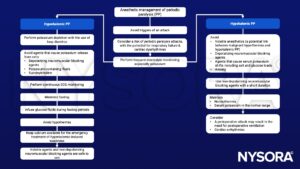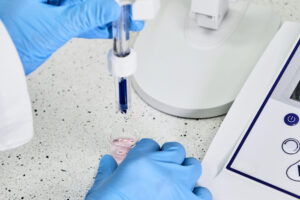Learning objectives
- Distinguish the four forms of periodic paralysis (PP)
- Anesthetic management of PP
Definition and mechanisms
- Periodic paralysis (PP) is a group of rare genetic diseases that lead to weakness or paralysis
- The underlying mechanisms of these diseases are malfunctions in the ion channels in skeletal muscle cell membranes that allow electrically charged ions to leak in or out of the muscle cell
- Thereby causing the cell to depolarize and become unable to move
- It causes sudden attacks of short-term muscle weakness, stiffness, or paralysis
- These attacks may affect the whole body or just 1 or 2 limbs
- Four forms of PP exist and most forms affect the skeletal muscles
Main forms
| Hypokalemic PP | Hyperkalemic PP | Thyrotoxic PP | Andersen-Tawil syndrome |
|---|---|---|---|
| Potassium leaks into the muscle cells from the bloodstream | Potassium leaks out of the cells into the bloodstream | High levels of thyroid hormone | Swings in potassium blood levels |
| Often starts in the late childhood or teenage years | Often starts by age 10 | It tends to start between 20 and 40 years of age | Usually starts before age 18 |
| Attacks of skeletal muscle weakness may last from a couple of hours to a day | Attacks of skeletal muscle weakness last an average of 30 minutes to 4 hours | Attacks happen anywhere from a few times per year to a few times per week Attacks can last from hours to days | The attacks last from 1 to 36 hours |
| Paralysis usually affects the limbs and trunk but spares the diaphragm Chronic muscle weakness occurs in most patients as they age | Acute attacks can be fatal because of cardiac dysrhythmias or respiratory failure A chronic myopathy frequently develops in older patients | The patient may also have thyroid-related symptoms such as anxiety, sweating, weight loss, and an abnormal sensation of the heartbeat (palpitations) | Includes significant heart rhythm problems, fainting, and risk of sudden death |
| The genetic defect is a rare autosomal dominant condition that results in defective calcium channels | The underlying abnormality is a dysfunctional sodium channel | It appears mostly in men, especially in those of Asian background | Set of facial features: a broad forehead, widely spaced eyes, low-set ears, and a small chin |
| Caused by: Strenuous exercise High carbohydrate meals Licorice Stress Cold temperatures Infusion of glucose and insulin | Caused by: Strenuous exercise Fasting stress Cold Infusion of potassium Metabolic acidosis Hypothermia | Caused by: Exercise High carbohydrate meals Stress | Caused by: Exercise Stress Certain medicines |
Signs and symptoms
- Attacks of muscle weakness that may last for minutes to days
- Muscle pain in muscles after exercise
- Muscle cramping
- Feeling tingles
- Permanent weakness, more likely later in life
Treatment
- Carbonic anhydrase inhibitors: acetazolamide, methazolamide or dichlorphenamide
- Hypokalemia:
- Supplemental oral potassium chloride
- Potassium-sparing diuretics
- Hyperkalemia:
- Avoid potassium
- Thiazide diuretics to increase the renal excretion of potassium
Anesthetic management

Suggested reading
- Marsh, S., Pittard, A., 2011. Neuromuscular disorders and anaesthesia. Part 2: specific neuromuscular disorders. Continuing Education in Anaesthesia Critical Care & Pain 11, 119–123.
We would love to hear from you. If you should detect any errors, email us customerservice@nysora.com







